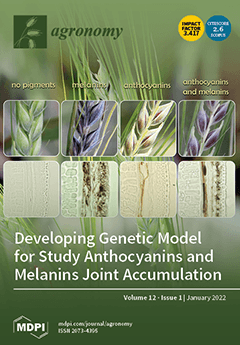In the tropics, warm temperatures and high rainfall contribute to acidic soil formation because of the significant leaching of base cations (K
+, Ca
2+, Mg
2+, and Na
+), followed by the replacement of the base cations with
[...] Read more.
In the tropics, warm temperatures and high rainfall contribute to acidic soil formation because of the significant leaching of base cations (K
+, Ca
2+, Mg
2+, and Na
+), followed by the replacement of the base cations with Al
3+, Fe
2+, and H
+ ions at the soil adsorption sites. The pH buffering capacity of highly weathered acid soils is generally low because of their low pH which negatively impacts soil and crop productivity. Thus, there is a need to amend these soils with the right amount of inorganic liming materials which have relatively high neutralizing values and reactivity to overcome the aforementioned problems. Soil leaching and the pH buffering capacity studies were conducted to determine whether the co-application or co-amendment of a calcium carbonate product (Calciprill) and sodium silicate can improve soil nutrient retention and pH buffering capacity of the Bekenu series (
Typic Paleudults). A 30 day soil leaching experiment was carried out using a completely randomized design with 16 treatments and 3 replications after which the leached soil samples were used for a pH buffering capacity study. The Calciprill and sodium silicate treatments significantly improved soil pH, exchangeable NH
4+, available P, exchangeable base cations, Effective Cation Exchange Capacity (ECEC), and pH buffering capacity in comparison with the untreated soil. The improvements were attributed to the alkalinity of Calciprill and sodium silicate due to their high inherent K
+, Ca
2+, Mg
2+, and Na
+ contents. The neutralizing effects of the amendments impeded the hydrolysis of Al
3+ (96.5%), Fe
2+ (70.4%), and Mn
2+ (25.3%) ions resulting in fewer H
+ ions being produced. The co-application of Calciprill and sodium silicate reduced the leaching of Ca
2+ (58.7%) and NO
3− (74.8%) from the amended soils. This was due to the ability of sodium silicate to reduce soil permeability and protect the Calciprill and available NO
3− from being leached. This also improved the longevity of Calciprill to enhance the soil pH buffering capacity. However, the amounts of NH
4+, P, and base cations leached from the amended soils were higher compared with the un-amended soils. This was due to the high solubility of sodium silicate. The most suitable combination amendment was 7.01 g Calciprill and 9.26 g sodium silicate (C2S5) per kilogram soil. It is possible for farmers to adopt the combined use Calciprill and sodium silicate to regulate soil nutrient retention and improve the soil pH buffering capacity of highly weathered acidic soils. This will enhance soil and crop productivity.
Full article





